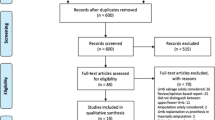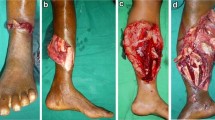Abstract
Background
The Mangled Extremity Severity Score (MESS) was constructed as an objective quantification criterion for limb trauma. A MESS of or greater than 7 was proposed as a cut-off point for primary limb amputation. Opinions concerning the predictive value of the MESS vary broadly in the literature. The aim of this study was to evaluate the applicability of the MESS in a contemporary civilian Central European cohort.
Methods
All patients treated for extremity injuries with arterial reconstruction at two centres between January 2005 and December 2014 were assessed. The MESS and the amputation rate were determined.
Results
Seventy-one patients met the inclusion criteria and could be evaluated for trauma mechanism and injury patterns. The mean MESS was 4.97 (CI 4.4–5.6). Seventy-three per cent of all patients (52/71) had a MESS < 7 and 27% (19/71) of ≥7. Eight patients (11%) underwent secondary amputation. Patients with a MESS ≥ 7 showed a higher, but statistically not significant secondary amputation rate (21.1%; 4/19) than those with a MESS < 7 (7.7%; 4/52; p = 0.20). The area under the ROC curve was 0.57 (95% CI 0.41; 0.73).
Conclusions
Based on these results, the MESS appears to be an inappropriate predictor for amputation in civilian settings in Central Europe possibly due to therapeutic advances in the treatment of orthopaedic, vascular, neurologic and soft-tissue traumas.

Similar content being viewed by others
References
Fox CJ, Gillespie DL, O’Donnell SD et al (2005) Contemporary management of wartime vascular trauma. J Vasc Surg 41:638–644
Doody O, Given MF, Lyon SM (2008) Extremities—indications and techniques for treatment of extremity vascular injuries. Injury 39:1295–1303
Menakuru SR, Behera A, Jindal R et al (2005) Extremity vascular trauma in civilian population: a seven-year review from North India. Injury 36:400–406
Rasouli MR, Moini M, Khaji A (2009) Civilian traumatic vascular injuries of the upper extremity: report of the Iranian national trauma project. Ann Thorac Cardiovasc Surg 15:389–393
Johansen K, Daines M, Howey T et al (1990) Objective criteria accurately predict amputation following lower extremity trauma. J Trauma 30:568–572 (discussion 572–573)
Korompilias AV, Beris AE, Lykissas MG et al (2009) The mangled extremity and attempt for limb salvage. J Orthop Surg Res 4:4
Prasarn ML, Helfet DL, Kloen P (2012) Management of the mangled extremity. Strateg Trauma Limb Reconstr 7:57–66
Bernstein ML, Chung KC (2007) Early management of the mangled upper extremity. Injury 8(Suppl 5):S3–S7
Mommsen P, Zeckey C, Hildebrand F et al (2010) Traumatic extremity arterial injury in children: epidemiology, diagnostics, treatment and prognostic value of Mangled Extremity Severity Score. J Orthop Surg Res 5:25
Prichayudh S, Verananvattna A, Sriussadaporn S et al (2009) Management of upper extremity vascular injury: outcome related to the Mangled Extremity Severity Score. World J Surg 33:857–863. https://doi.org/10.1007/s00268-008-9902-4
Rush RM Jr, Kjorstad R, Starnes BW et al (2007) Application of the Mangled Extremity Severity Score in a combat setting. Mil Med 172:777–781
Sharma S, Devgan A, Marya KM et al (2003) Critical evaluation of mangled extremity severity scoring system in Indian patients. Injury 34:493–496
Brown KV, Ramasamy A, McLeod J et al (2009) Predicting the need for early amputation in ballistic mangled extremity injuries. J Trauma 66:S93–S97 (discussion S97–S98)
Johansen K, Hansen ST Jr (2015) MESS (Mangled Extremity Severity Score) 25 years on: time for a reboot? J Trauma Acute Care Surg 79:495–496
Tscherne H (1997) Polytrauma management, 1st edn. Springer, Heidelberg
Perkins ZB, Yet B, Glasgow S (2015) Meta-analysis of prognostic factors for amputation following surgical repair of lower extremity vascular trauma. Br J Surg 102:436–450
Barla M, Gavanier B, Mangin M et al (2017) Is amputation a viable treatment option in lower extremity trauma? Orthop Traumatol Surg Res 103:971–975
Loja MN, Sammann A, DuBose J (2017) The mangled extremity score and amputation: time for a revision. J Trauma Acute Care Surg 82:518–523
Melcer T, Sechriest VF, Wlaker J et al (2013) A comparison of health outcomes for combat amputee and limb salvage patients injured in Iraq and Afghanistan wars. J Trauma Acute Care Surg 75:S247–S254
Tennent DJ, Wenke JC, Rivera JC (2014) Characterisation and outcomes of upper extremity amputations. Injury 45:965–969
Miller EA, Iannuzzi NP, Kennedy SA (2018) Management of the mangled upper extremity: a critical analysis review. JBJS Rev 6:e11
Polonet D, Rose MI, Brown DJ (2017) Amputation versus limb salvage of the lower extremity. In: Elkwood A, Kaufman M, Schneider L (eds) Rehabilitative surgery. Springer, Cham, pp 217–232
van Dongen TT, Huizinga EP, de Kruijff LG (2017) Amputation: not a failure for severe lower extremity combat injury. Injury 48:371–377
Funding
The study was not supported by any funding sources.
Author information
Authors and Affiliations
Corresponding author
Ethics declarations
Conflict of interest
The authors declare that they have no conflict of interest.
Ethical details
This study was approved by the local Ethics Committee (27-460 ex 14/15) in accordance with the principles of the Declaration of Helsinki and the ICH-GCP Guidelines.
Informed consent
Informed consent was obtained from all individual participants included in the study.
Additional information
Publisher's Note
Springer Nature remains neutral with regard to jurisdictional claims in published maps and institutional affiliations.
Rights and permissions
About this article
Cite this article
Hohenberger, G.M., Konstantiniuk, P., Cambiaso-Daniel, J. et al. The Mangled Extremity Severity Score Fails to be a Good Predictor for Secondary Limb Amputation After Trauma with Vascular Injury in Central Europe. World J Surg 44, 773–779 (2020). https://doi.org/10.1007/s00268-019-05263-w
Published:
Issue Date:
DOI: https://doi.org/10.1007/s00268-019-05263-w




